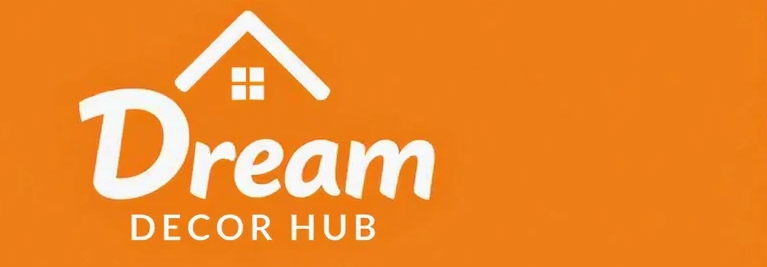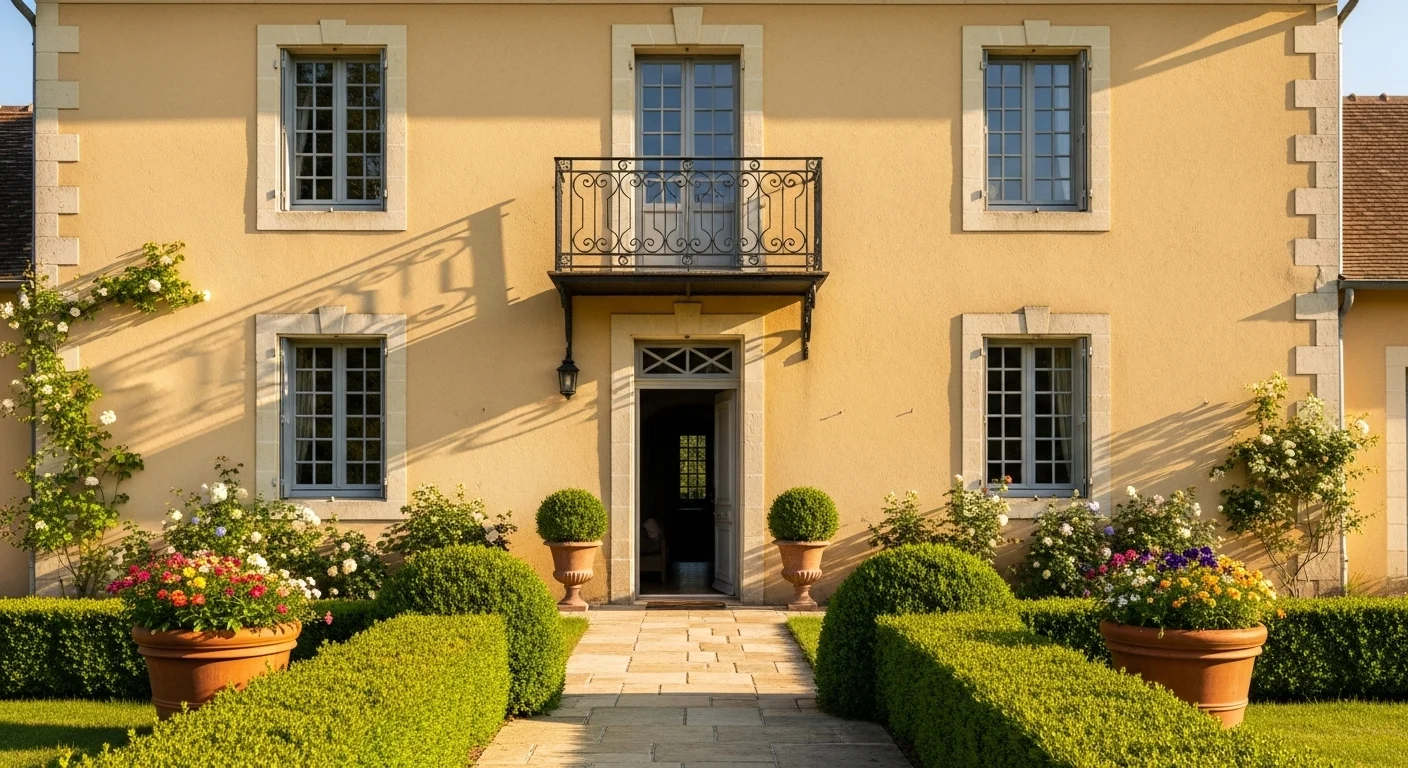Your house exterior probably looks like every other suburban home on your street—safe, boring, and absolutely forgettable. Meanwhile, you’ve been pinning those gorgeous French country homes with their warm stone, charming shutters, and that effortlessly elegant vibe that makes you want to book a flight to Provence immediately.
The French country aesthetic isn’t just about slapping on some shutters and calling it European. It’s about understanding the materials, proportions, and details that create that timeless, lived-in elegance. Think natural stone that ages beautifully, authentic materials that develop patina, and architectural details that look intentional rather than tacked on.
Whether you’re planning a full renovation or just dreaming about what’s possible, these exterior approaches can help you capture that sophisticated French countryside charm without looking like a theme park version. Ready to transform your home’s curb appeal into something worthy of a magazine spread? Let’s break down what actually works.
Foundation Elements That Matter
Before you start shopping for limestone and olive trees, let’s talk about what actually creates authentic French country style in exterior design.
Material Authenticity First – Real stone, actual timber, and quality plaster create the foundation. Vinyl siding painted to look like stone will never achieve the same effect, no matter how good the paint job.
Proportion and Symmetry – French country homes often feature balanced, symmetrical arrangements that feel formal without being stuffy. Window placement, door centering, and architectural elements should relate to each other intentionally.
Color Palette Restraint – Stick to warm neutrals, natural stone tones, and muted accent colors. The French country palette is subtle and sophisticated, not bright or trendy.
Architectural Detail Quality – Shutters should look functional, doors should be substantial, and trim details should appear structural rather than purely decorative.
Think Like a French Architect
The most successful French country exteriors blend traditional materials with livable modern functionality.
Regional Authenticity – Different regions of France have distinct architectural styles. Provence looks different from Normandy. Choose details that work together cohesively rather than mixing every French influence.
Landscape Integration – Your plantings should complement the architecture. Think lavender, boxwood, olive trees, and roses rather than tropical palms or overly manicured foundation shrubs.
Aging Gracefully – Choose materials that improve with weathering. Stone develops beautiful patina, wood gains character, and natural materials tell stories over time.
Modern Updates Hidden – Contemporary necessities like garage doors, security systems, and lighting should be integrated discreetly to maintain the timeless aesthetic.
15 French House Exterior Ideas
Honeyed Limestone with Lavender Accents
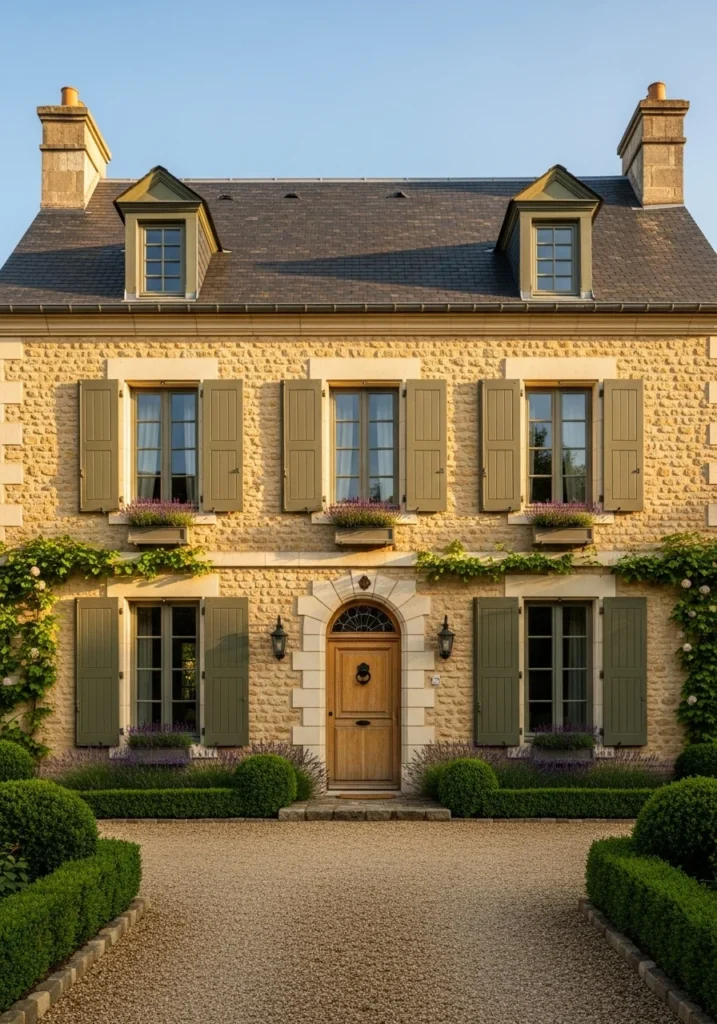
Build your facade around warm limestone in honey tones, paired with aged oak shutters in deep olive green. The combination creates instant French countryside authenticity while the natural stone ensures beautiful aging over decades.
Center an arched oak door with wrought-iron hardware and flank it with casement windows featuring lavender boxes. Gravel drives and clipped boxwood borders complete the classic Provençal approach. The slate roof with modest dormers adds vertical interest without overwhelming the proportions.
White Plaster Provençal Simplicity
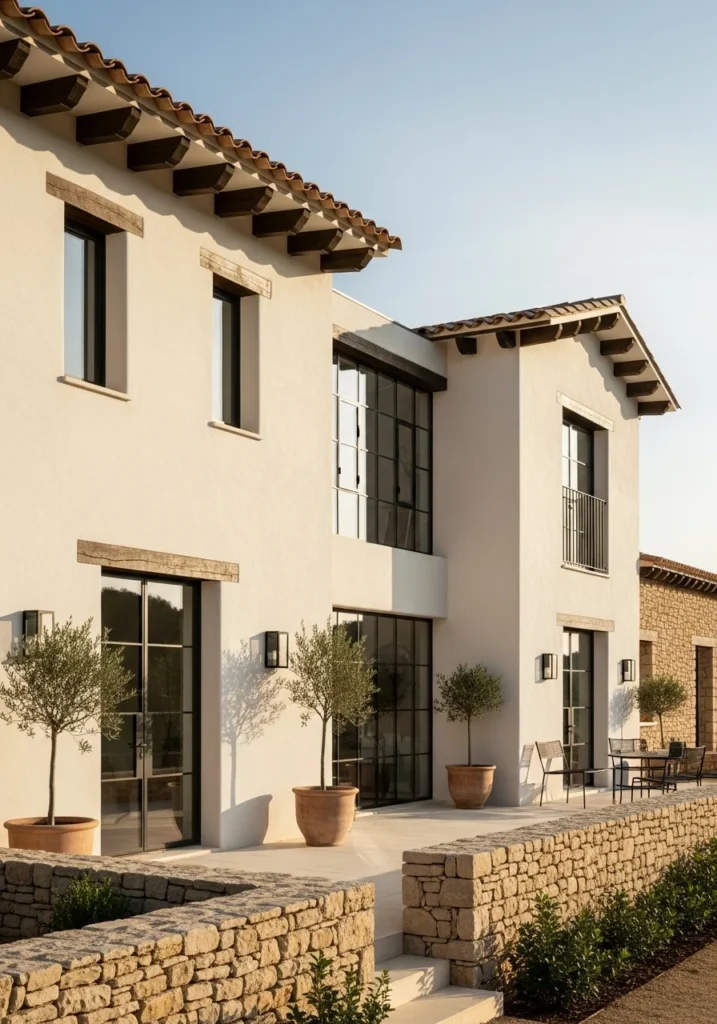
Create a clean, modern interpretation with warm white plaster walls and exposed dark timber eaves. This pared-down approach captures Provençal spirit while feeling contemporary and uncluttered.
Black steel casement windows provide modern contrast while dwarf olive trees in terracotta pots bring Mediterranean authenticity. Low stone walls define boundaries without blocking sightlines, maintaining an open, welcoming feel.
Stone Quoins with Black Window Frames
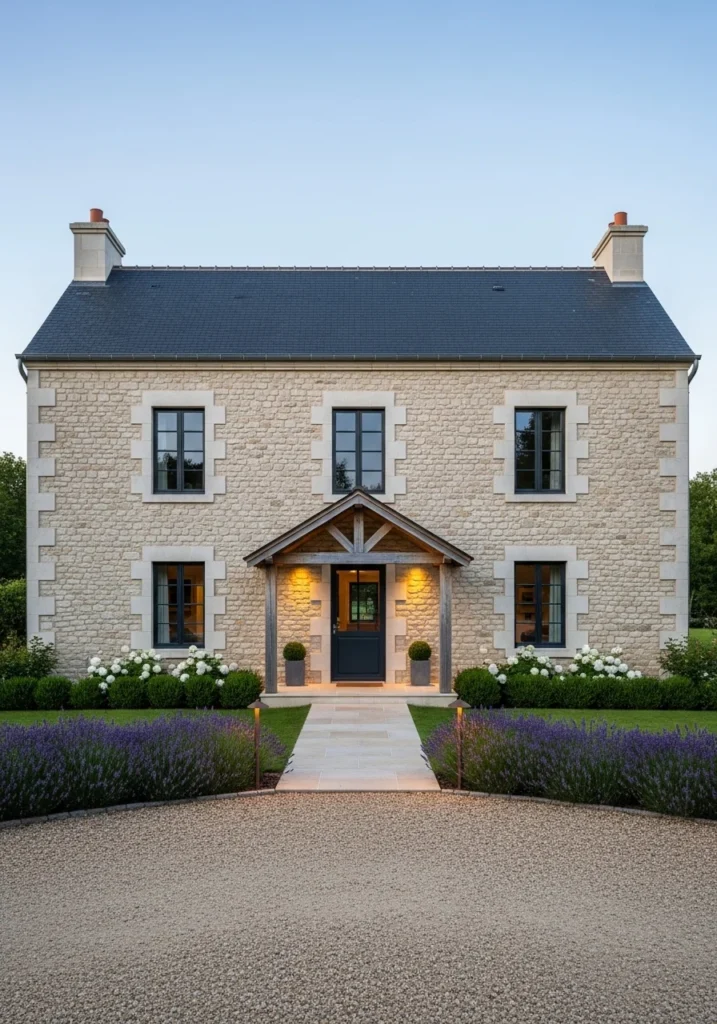
Emphasize architectural structure with pronounced corner quoins in natural stone paired with crisp black-framed windows. This detail-focused approach creates sophisticated definition without requiring elaborate ornamentation.
A simple cedar-clad porch adds warmth while bronze lighting fixtures provide evening illumination with period-appropriate styling. Stone paving and lavender plantings soften the approach while maintaining the refined aesthetic.
Fluted Stucco with Arched Entry
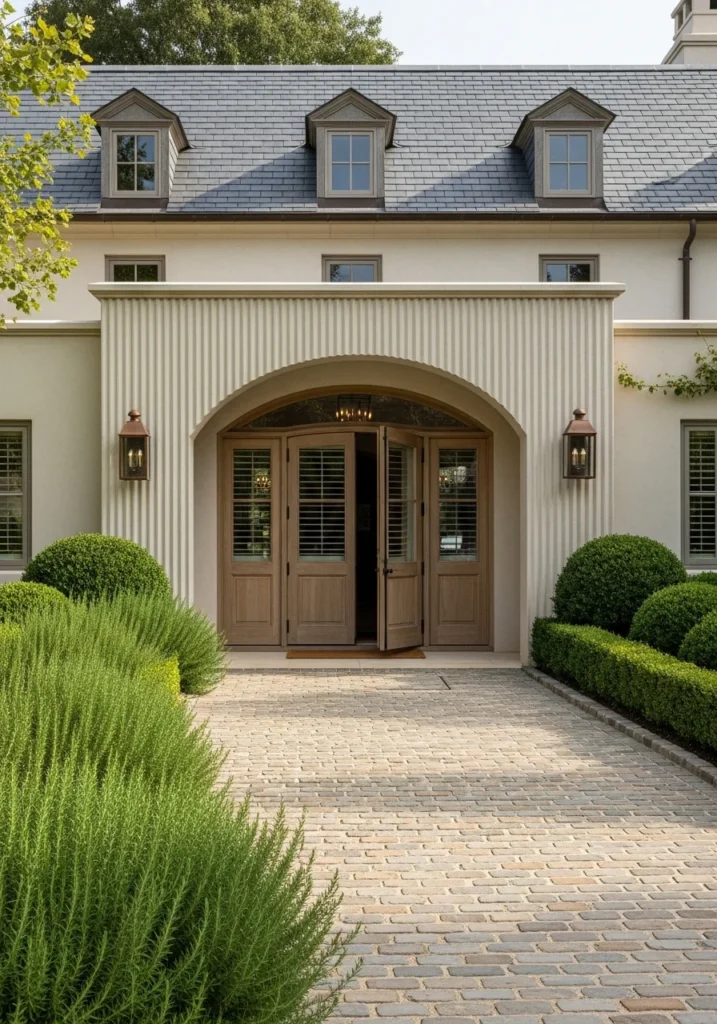
Design around a central low-arched entryway that creates immediate focal interest. Soft fluted stucco adds subtle texture while weathered oak doors and shutters bring natural warmth.
Cobblestone drives edged with rosemary and boxwood create authentic Mediterranean atmosphere. The slate roof with small dormers provides classic proportions while the understated materials prevent the look from feeling overwrought.
Warm Brick and Timber Blend
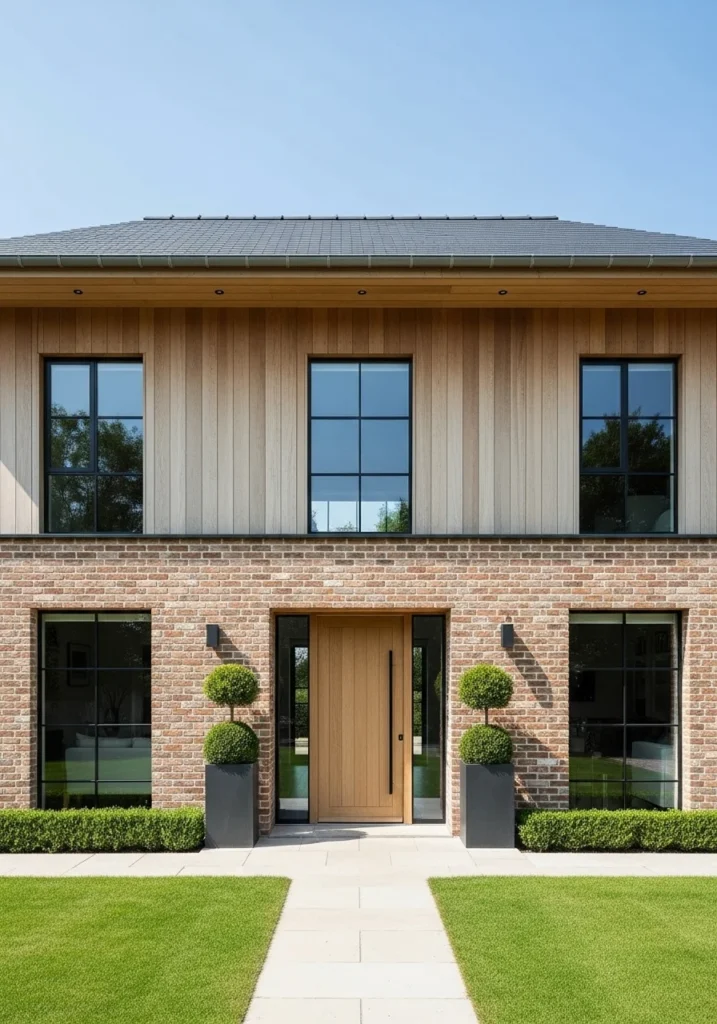
Combine soft brick on the lower level with vertical timber cladding above for contemporary French country fusion. This mixed-material approach adds visual interest while maintaining warmth and texture.
Black steel-framed windows provide modern glazing within traditional forms. The center entry with modern oak door balances contemporary function with classic proportions. Symmetrical plantings and trimmed lawns create order without formality.
Cream Cottage
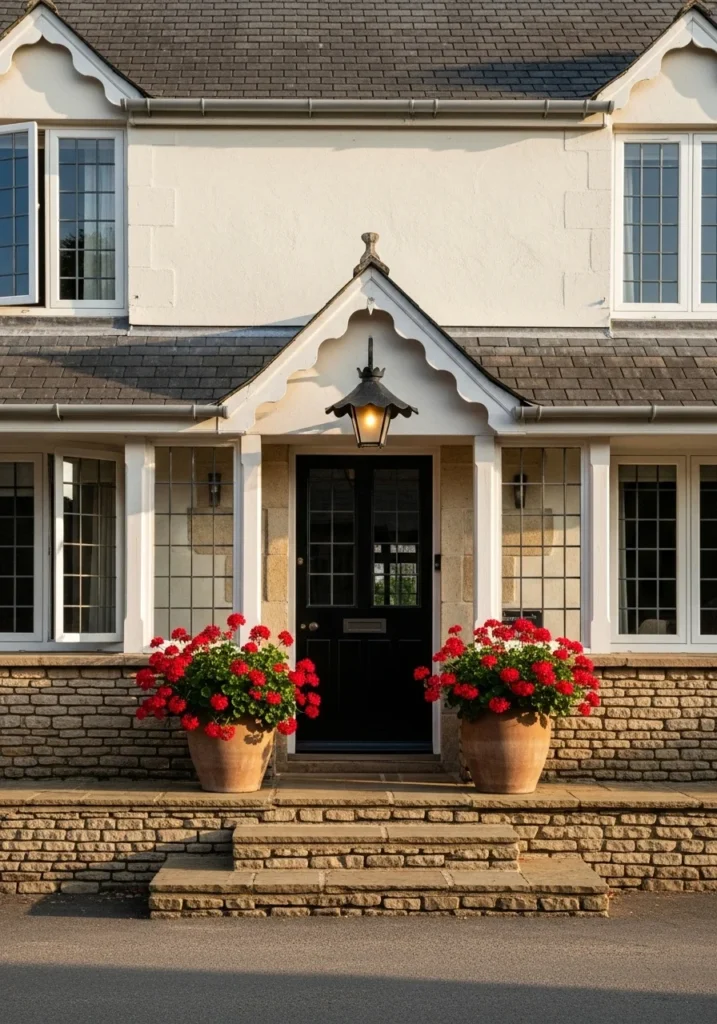
Create storybook charm with cream-painted walls and leaded casement windows that add architectural character. The low stacked-stone porch with wide shallow steps provides welcoming transition from landscape to interior.
Potted geraniums and scalloped iron lanterns add classic cottage details while the slate roof with petite gable maintains proper scale. This approach works particularly well for smaller homes where every detail contributes to overall charm.
Also Read: How to Style a Kids Bathroom That’s Actually Functional (Not Just Instagram Cute)
Modern Rustic with Limestone Banding
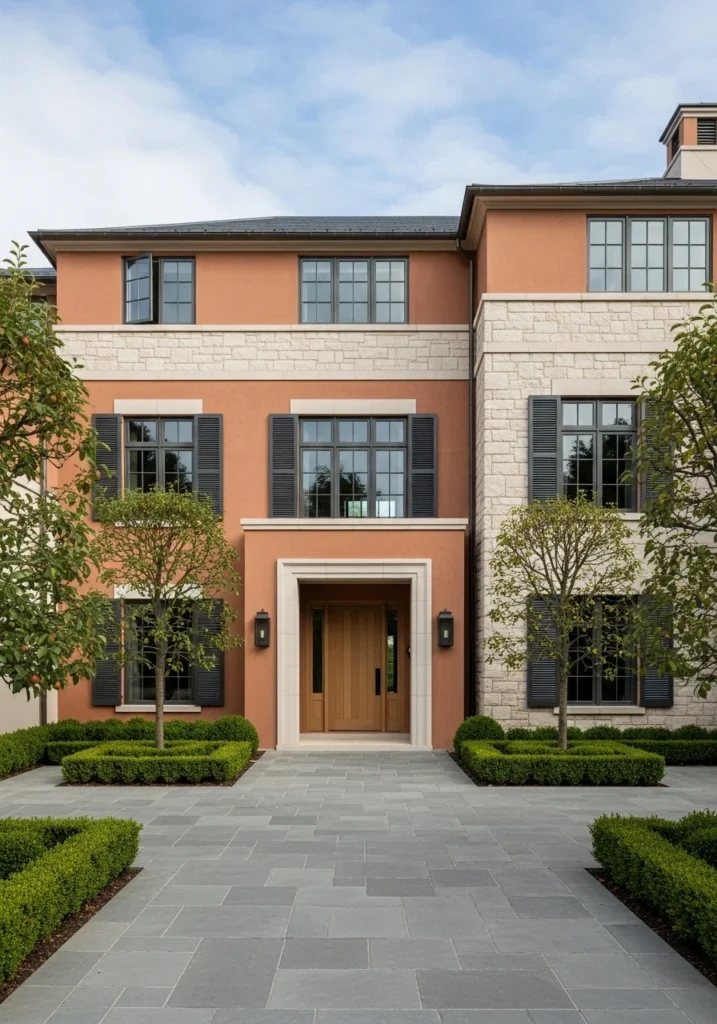
Add architectural definition with limestone belt courses against warm plaster walls. This subtle detailing creates horizontal emphasis while matte black shutters provide strong contrast and contemporary edge.
A recessed entry adds shadow and depth while straight paved drives with clipped hedges maintain clean geometry. Specimen fruit trees provide vertical interest and seasonal change without overwhelming the architecture.
Pale Taupe with Wrought Iron Details
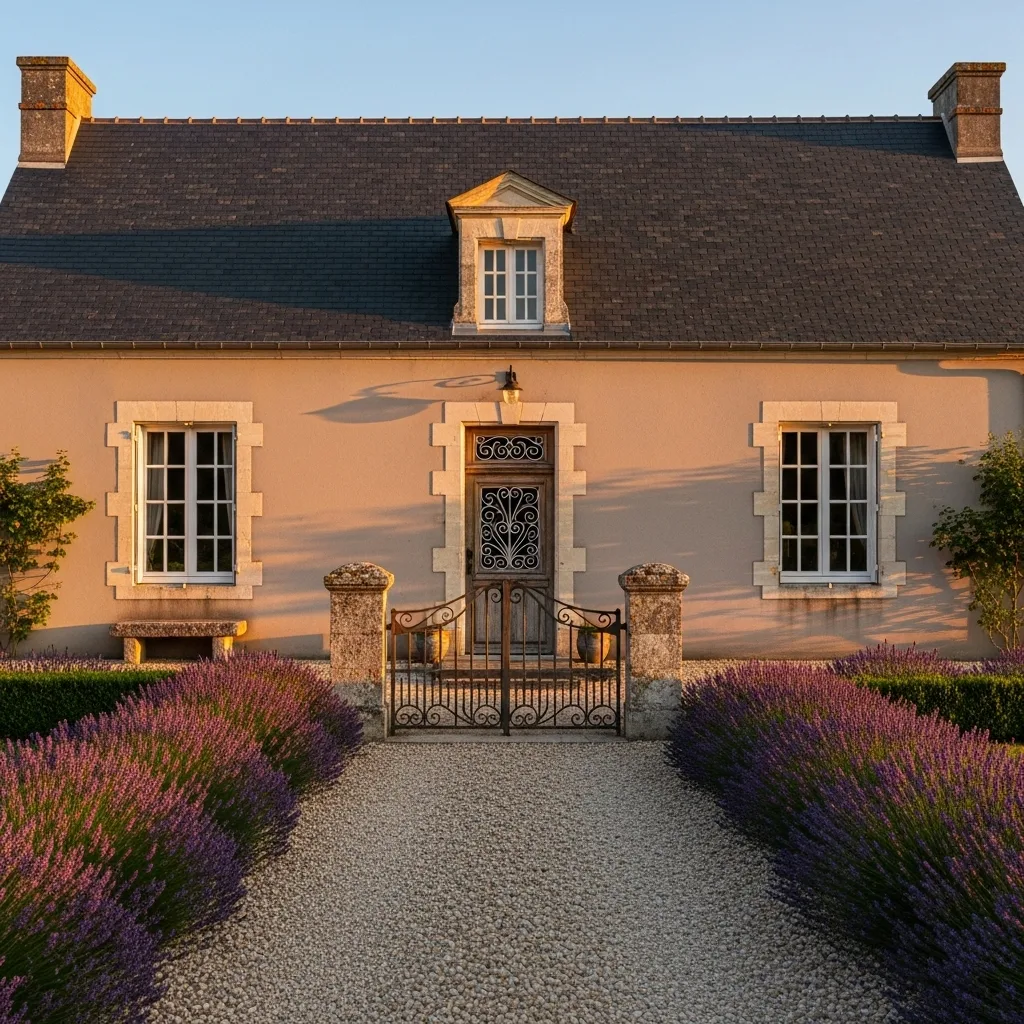
Build around soft taupe render with charcoal slate roofing for sophisticated neutral palette. The centered timber door with decorative wrought-iron grille becomes a jewelry-like focal point.
Pebble drives and wrought-iron gates with stone posts create authentic period details while lavender beds and stone benches add living elements. This combination works well for homes seeking understated elegance.
Stone Facade with Terracotta Shutters
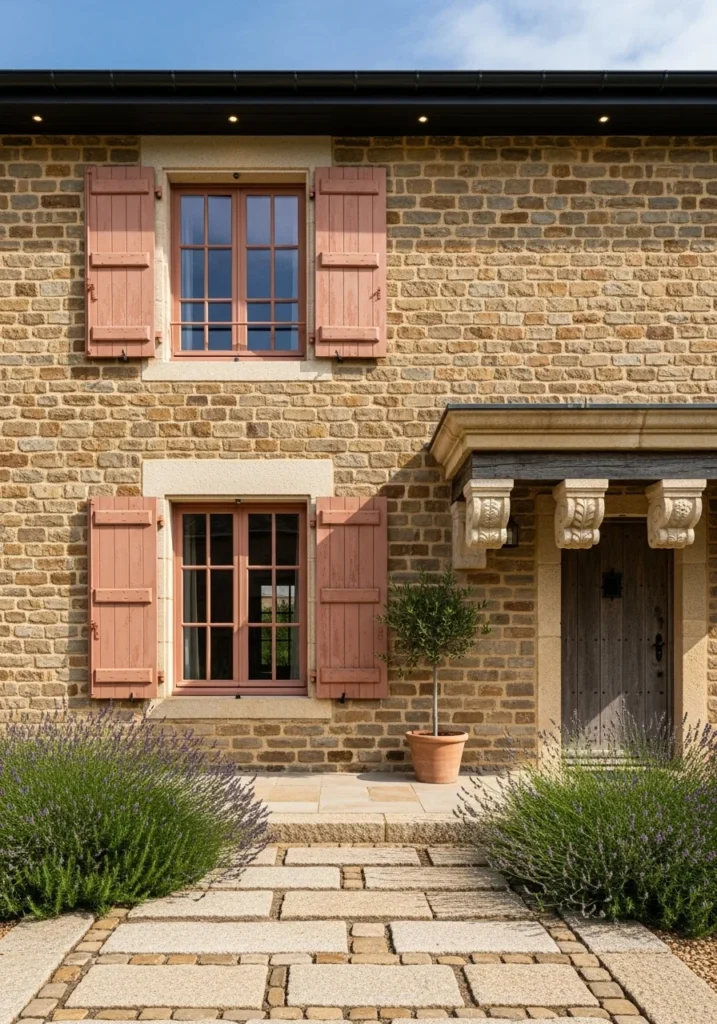
Pair warm natural stone with soft terracotta-painted shutters for classic Provençal color harmony. The modest stone porch with carved corbels adds architectural interest while maintaining human scale.
Modern touches like slim black guttering and recessed lighting keep the look current rather than costume-like. Reclaimed stone paving adds authentic texture and weathered character from day one.
Two-Tone Render with Oak Canopy
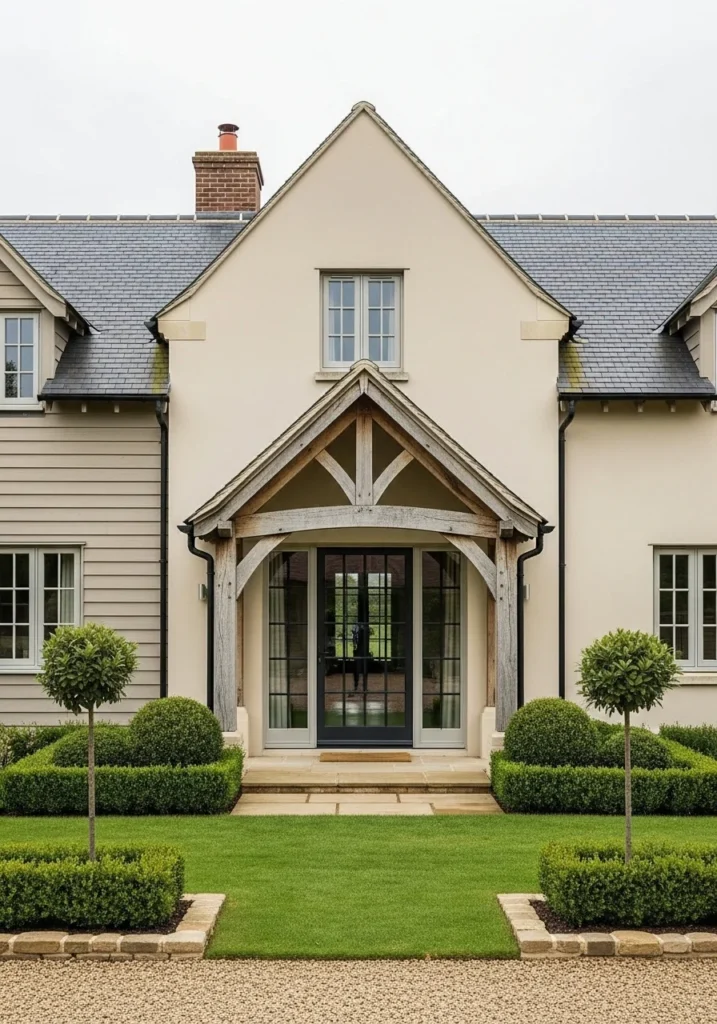
Create visual interest through two-tone render in cream and pale taupe. An oak canopy over the entry provides shelter while adding substantial architectural presence to the facade.
Glazed French doors with black mullions maximize light while maintaining traditional proportions. Trimmed lawn panels and clipped yew topiaries create formal garden structure that complements the architectural symmetry.
Pale Limestone with Stepped Gable
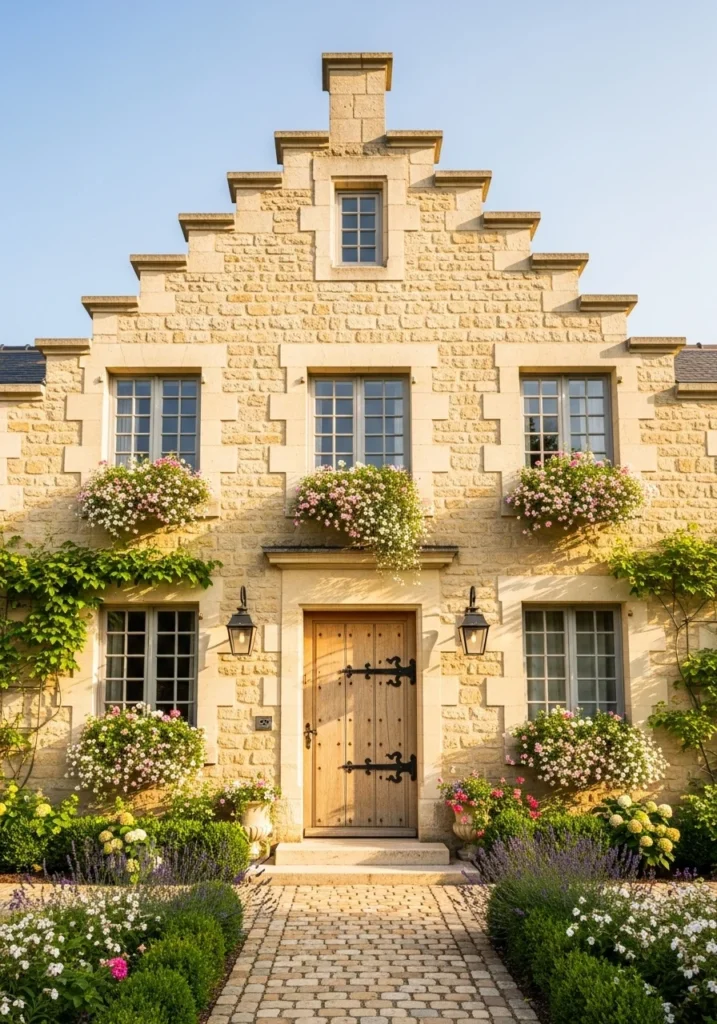
Design around a distinctive stepped gable silhouette that creates memorable roofline interest. Abundant windowboxes with seasonal blooms add living color while the pale limestone provides neutral backdrop.
A central timber door with iron strap hinges maintains period authenticity while cobbled approaches and traditional lanterns complete the classic French cottage aesthetic. This works well for homes with character and personality.
Slate-Clad Dormers with Green Shutters
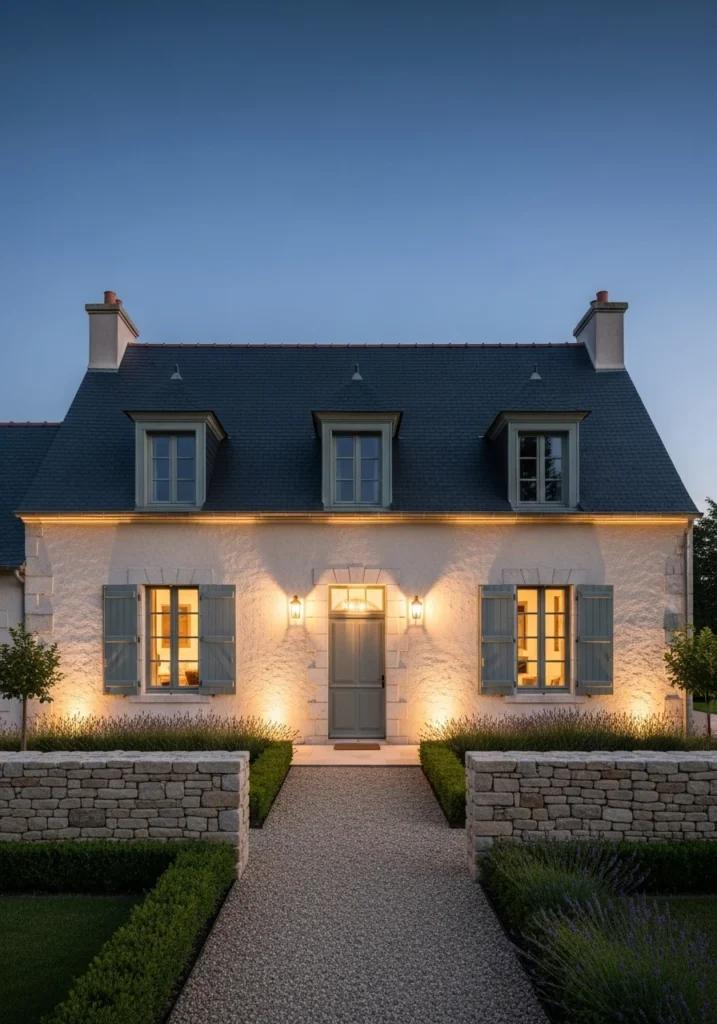
Feature full-height slate-clad dormers that create dramatic vertical elements against warm plaster walls. Fixed timber shutters in muted green add color while maintaining the natural material palette.
Low stone walls with gravel paths and lavender hedges create Mediterranean garden structure. Exterior uplighting at dusk transforms the facade into evening focal point while emphasizing architectural details.
Symmetrical Bays with Stone Quoins
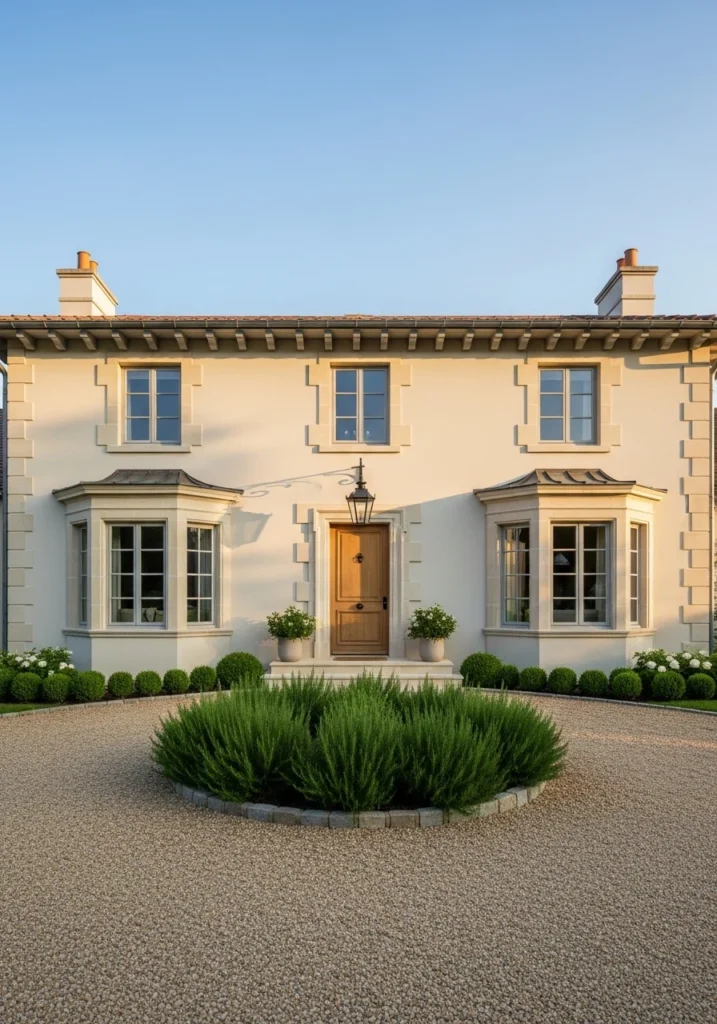
Design around symmetrical bay windows flanking a central doorway for balanced, formal composition. Cream render with subtle stone quoins adds architectural definition without overwhelming the clean facade.
Gravel driveways with circular planting beds create arrival moments while classic lanterns and exposed rafters maintain period-appropriate detailing. This approach works well for larger homes requiring visual weight.
Timber-Clad Gable with Linen Canopy
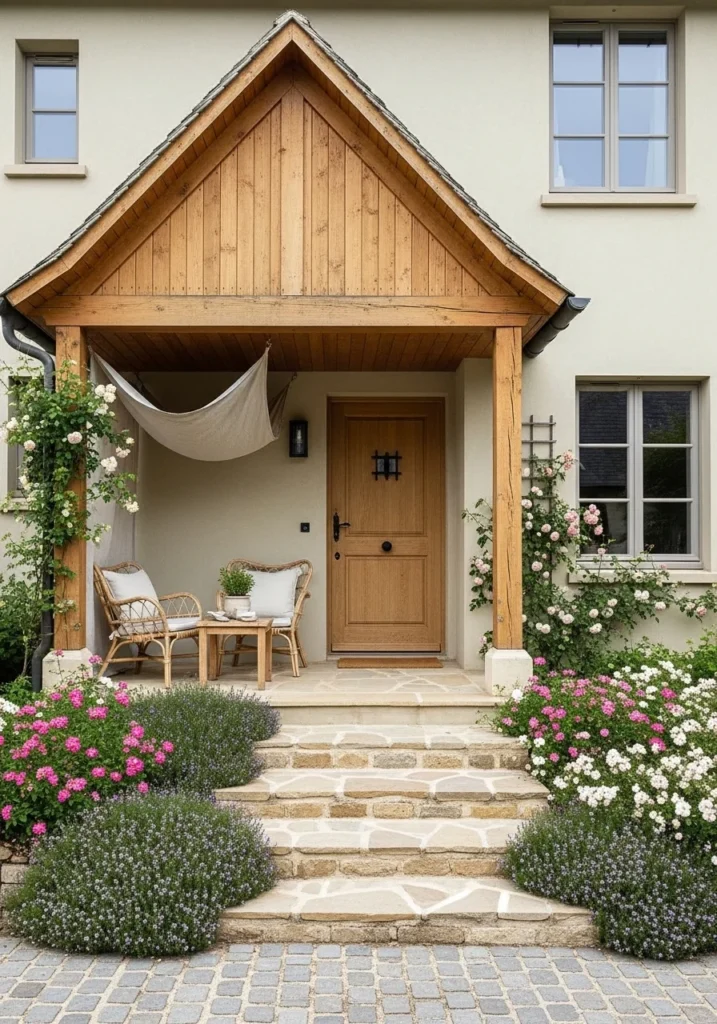
Combine warm timber-clad gable with pale limewashed walls for textural contrast. A narrow covered porch with natural linen canopy provides sheltered entry while adding soft, organic element.
Simple stone steps and plantings of thyme and dwarf roses create cottage-garden approach. Hand-finished oak doors add craftsmanship quality that elevates the entire composition.
Pale Ochre with Iron Balcony
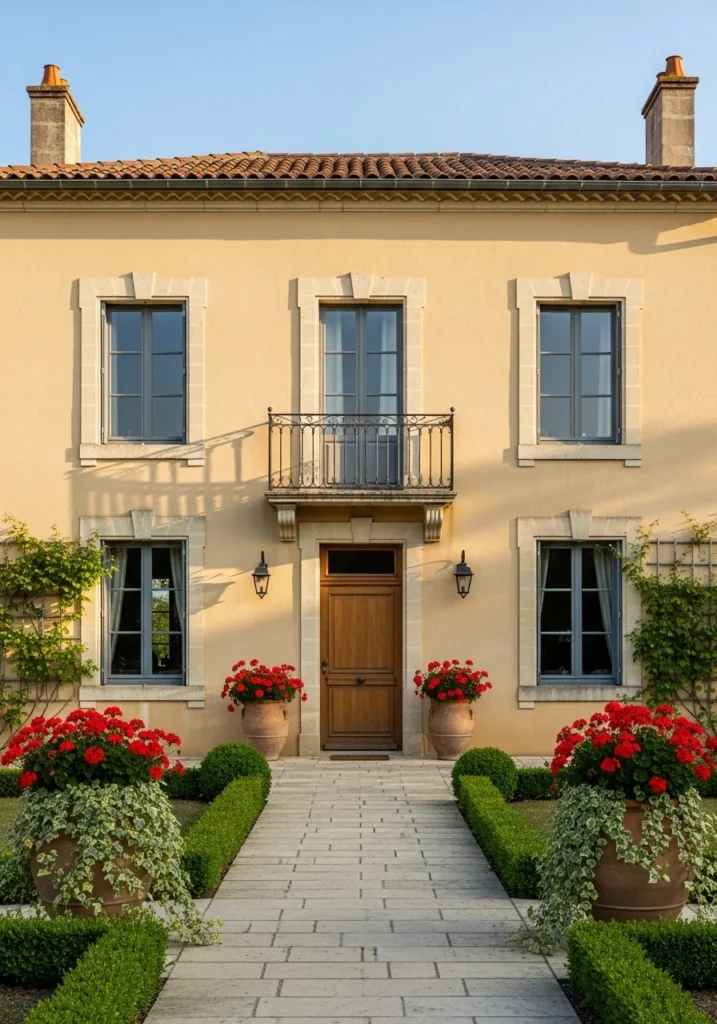
Build around warm ochre render with small wrought-iron Juliet balcony above the central entrance. Balanced pairs of casement windows create formal symmetry while maintaining livable scale.
Flagstone paths and clipped box hedges provide structured landscape elements while terracotta pots add warmth and flexibility for seasonal changes. This refined provincial style works across various home sizes.
Creating Authentic French Country Style
Achieving genuine French country aesthetic requires understanding that it’s not about adding decorative elements to an existing house—it’s about fundamental architectural choices in materials, proportions, and details.
The most successful transformations start with good bones and authentic materials rather than surface treatments. Real stone, quality timber, and proper proportions create foundations that look better with age rather than showing wear.
When your home starts feeling like it’s always been there rather than recently renovated, you’ll know you’ve captured the timeless quality that makes French country architecture so enduringly appealing.
